EFO RF Wireless Handheld Keyboard

|
Review: EFO RF Wireless Handheld Keyboard
Everyone comes to a point sooner or later where having a remote control in front of you just doesn’t meet all of your needs. For those times it is handy to have a keyboard nearby. But who wants to lug out a big keyboard that tethers you to the HTPC? It’s much more convenient to use something wireless and easy to hide. Let’s have a look at an offering from EFO to see if it fits your needs. |
Hardware Stuff
There is not a lot to see in the packaging used by EFO. They chose to enclose this keyboard in plastic clamshell packaging which works well enough to protect the keyboard because there isn’t much in the way of moving parts. The only part that might be in danger is the touchpad, but I don’t think there is any need to worry about it.
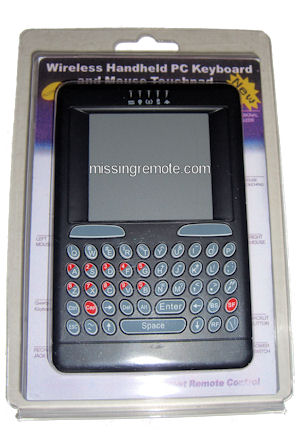 |
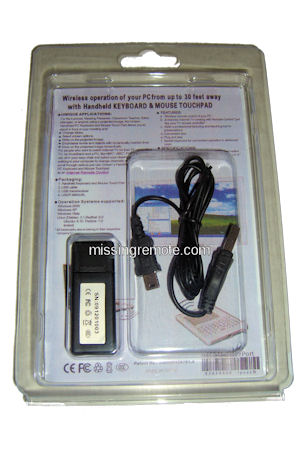 |
| Package front | Package back |
Included inside the packaging is the keyboard itself, a sheet listing the unit’s features, the USB RF receiver and a USB cable. The USB cable is used to charge the keyboard but not to make the keyboard work with your PC. Instead, you use the RF receiver. One comment on the feature sheet, it looks like someone took a digital photo of the prototype spec sheet and then started printing it on their home PC.
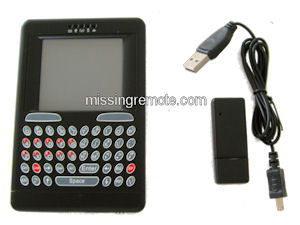 |
| Package contents |
There’s not a lot to say about the keyboard itself. The front side is where most of the action is at. At the very top are 5 status indicators: charge indicator, external power, RF status, battery power, Caps Lock or Secondary Function. Directly below those is the touchpad and right and left mouse buttons. Below the touchpad area is a keyboard with 46 keys. The back of the keyboard holds a serial number but is otherwise devoid of anything interesting. The base of the unit contains the USB interface and an on/off switch. Similar to the top, there is nothing of interest on the top or sides of the keyboard, only the seam where the front meets the back.
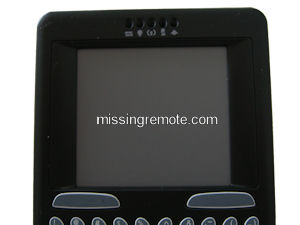 |
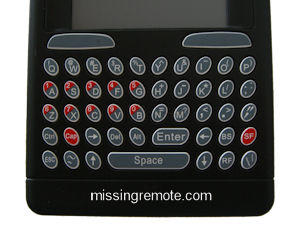 |
| Touchpad | Keyboard |
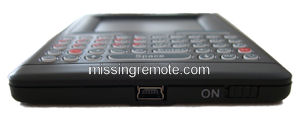 |
|
| USB port and power switch | |
Setup/Usage
Setup for this keyboard was literally as simple as charging the keyboard battery with the supplied USB cable, attaching the RF USB dongle, and then powering up the keyboard. I let my unit charge for a couple of hours before growing too impatient with it so that I could test it. One nice thing about this keyboard is that when the battery gets low the second indicator lights turns on; when it gets really low, the first one turns on as well (documented but not tested – after a week of solid use of this keyboard I still have yet to recharge the battery).
This keyboard is definitely not your regular full-sized keyboard, but if you are familiar with cell phone keyboards you will probably have no
trouble with it. Due to the space constraints the buttons are
very small so you may have trouble hitting the key you want if you have
larger fingers, and you also lose a few "extra" keys. For example, there are no keys for TAB, shift (only Caps lock), Windows, all function keys, page up/down, home/end, etc. The letters are arranged in your standard QWERTY layout but the numbers are secondary functions of the letters, so the QWERTY row is the top row. The arrow keys are split on either side of the Spacebar, and punctuation keys are also secondary functions for the letters. There are single function keys for Ctrl, Alt, Del, Backspace, Esc, Spacebar and the arrows. All of the other keys are dual purpose.
The right and left mouse buttons each seem to have two contacts so you can hit the buttons anywhere you want instead of one specific spot. The same is true for the Enter key and Spacebar.
Conclusion
This is not a desktop replacement keyboard, nor is it meant to be. The only gaming that I can recommend it for would be Solitaire. Without some of those missing keys, general use for word processing or web surfing can be awkward. That being said, this keyboard is great on those occasions where you find yourself needing more than a remote by your side but don’t want to haul out a full sized keyboard. Just leave the USB plug attached to the back of your HTPC where it will not be seen and leave it on an end table or safely tucked between your couch cushions for easy access. Once I got used to the feel and general layout of the keys I found it easy enough to work with. The range is excellent as well; I was able to maintain connectivity throughout my entire house including through floors/ceilings and walls. That would be around 25 to 30 feet.
Pros:
- No driver necessary
- Very small size
- On/off switch for power savings when not in use
- Rechargeable battery
- Backlit keyboard
- RF interface (wireless and not line of site)
- Good range
Cons:
- Lots of "regular" keys are not present – Tab, Shift, etc
- Non-standard key layout
- No marked keys (different shapes or tabs) to indicate where you are on the keyboard without looking down
- No scroll wheel
Overall, I really like this keyboard for the Home Theater environment. I would not use it for my everyday PC but it works great or the occasional maintenance or a quick web surfing. It hardly weighs anything so your arms will not get tired if you do put it through extended use. My only big complaint is with the missing keys. I could have really used a Tab key to switch between applications or to navigate web forms, and function keys to close apps or refresh web pages; other than that it does everything I need it to. And considering its size, I am OK giving up a couple of keys. Once I got used to the key layout I found myself able to type rather efficiently with it. Yes, I wrote up this entire review with the EFO RF Wireless Handheld Keyboard. Available for $40 I think that it is a great value.
I would like to thank EFO for supplying us with review units.
